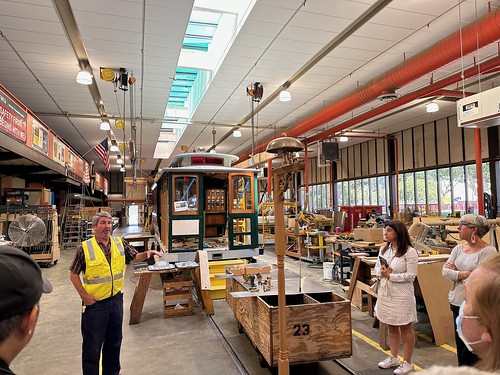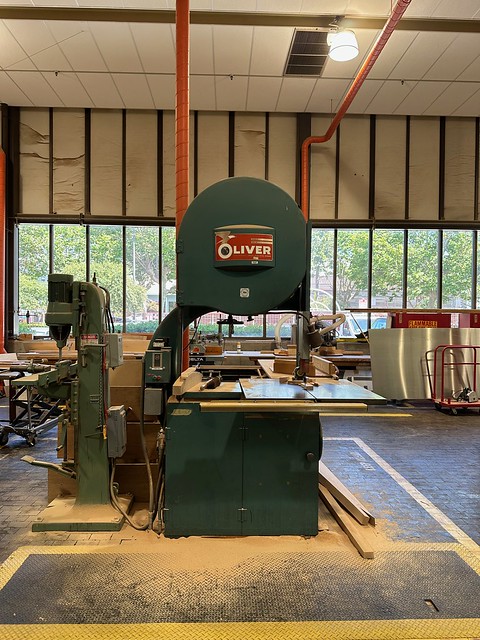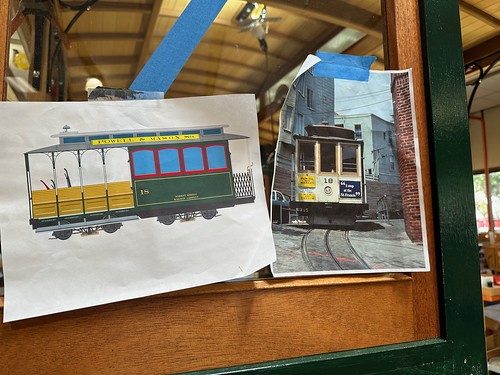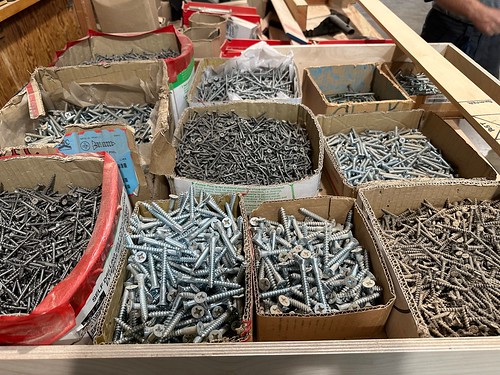
Last week I was lucky enough to get a rare glimpse inside the workshop where the most worn out San Francisco cable cars are sent to be restored — if not rebuilt. This was part of a tour offered by Muni, San Francisco’s public transit agency, in conjunction with the non-profit Market Street Railway to celebrate the 150th anniversary of the cable cars.
But let’s back up a moment, because there’s a few things to unpack here.
While the cable car system is 150 years old, the cable cars themselves only last as long as the wood they’re made from. Although regular maintenance keeps them in service for decades both time and weather will always take their toll eventually.
At some point all the cable cars have to be taken apart and rebuilt. And that’s where the cable car shop comes in. All of the woodworking is performed in-house by a small team of carpenters at this shop in the Dogpatch neighborhood.
The tour was inside the main room of the workshop itself, which isn’t normally open to the public. The shop was on an extended break during the tour as it obviously wouldn’t be safe to have the public in there while dangerous and loud machinery is in use.
On my visit there were two cable cars in the shop: the number 18 which they’ve mostly finished rebuilding, and a former car labeled 60 which was being disassembled and appeared to be in poor shape.

The brass parts are not made or restored at the shop; instead those are sent to other companies around the Bay Area that specialize in metal work. The parts that can be salvaged are sent off to be refinished. When new parts are required, the shop can pull out the molds and send them off to have new parts cast.
The photo of the bell above is the one used in the cable car bell ringing contest, and there’s a photo of the cast of the bell below it.
If like the Tin Man from the Wizard of Oz every part of a cable car can be replaced, what does it even mean to be original or authentic? Who am I to say; that’s a philosophical question for the ages.

The most amazing fact about this entire operation is that it’s still performed here, in an expensive city, by a team of union contractors employed by the people. But then again, if you need to fix a cable car it’s not like you can go on Amazon and order new parts. This is more akin to having custom cabinets made for your kitchen… if those cabinets had to last 40+ years outside and get lugged up and down hills all day.
I should mention the brakes. As with most trains the cable cars have metal wheels so they cannot brake quickly while maintaining traction, especially on hills — in other words they may slide. There are many solutions to this but the important one here is called a “track brake.” This is a wide term used for any type of train brake that uses the track itself instead of the wheels to decrease speed.
The cable cars use several pieces of wood mechanically pressed against the tracks as a brake. Depending on the weather these wooden track brakes last anywhere from nearly a week down to only a single day. Muni’s cable car shop makes these brakes on a regular basis and keeps a large stock on hand.

The funny red vehicle in the photo above is a tiny automobile built for pushing the cable cars around the shop. As you have have noticed the tracks in the shop don’t even have a slot for the cables. So they rely on this weird old car with a Ford Model A engine. Hey if it works it works.
All of this made me realize I don’t know nearly as much about the cable cars as I thought I did. Here are a few other things I learned that didn’t fit in anywhere else:
Miscellaneous factoids
- There’s a smaller team of cable car carpenters who work in the maintenance facility at the Cable Car Museum.
- They call the bell on top of the cable car a “gong” to differentiate it from the small bells the conductor rings inside the car.
- The sign outside the cable car shop says “San Francisco Municipal Transit System.” However, Muni is actually short for “San Francisco Municipal Railway.”
- The electric lights in today’s cable cars are powered by batteries under the seats. This lighting system replaced the original kerosene lanterns for obvious safety reasons.
- On the two Powell St. lines it used to be difficult to change the sign on the top of the car. At some point in the 1970’s a Muni employee invented a manual lever that lets them easily flip between the two.
- Possible spoiler(?) but tucked away in a storage shed somewhere are some freshly rebuilt cable cars that haven’t been used yet.
- The tour only included the first floor. Not sure what was on the second floor area but it wasn’t big enough to be hiding any cable cars.
- Tony Bennett, who infamously “left his heart in San Francisco” happened to pass away the same day I took this tour. In a strange coincidence, the number 18 cable car being rebuilt was originally numbered 518 and SF Gate has a photo of Bennett standing in front of it in 1967.








